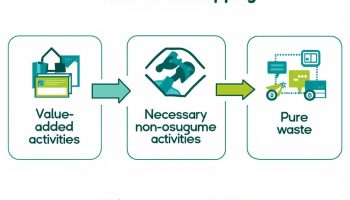
Introduction to Lean Six Sigma
Lean Six Sigma represents a powerful data-driven methodology that combines efficiency and quality improvement techniques to transform business processes across industries. By integrating the waste reduction principles of Lean with the statistical precision of Six Sigma, organizations can achieve dramatic improvements in operational performance, targeting defect rates as low as 3.4 per million opportunities.
Key Takeaways
- Lean Six Sigma merges two complementary methodologies to address both process efficiency and quality control simultaneously.
- The approach provides a structured framework (DMAIC) for identifying and eliminating process variations and waste.
- Organizations implementing Lean Six Sigma typically experience 20-30% reductions in process cycle times and defect rates.
- The methodology offers a progressive certification path from White Belt to Master Black Belt, enabling skill development.
- Successful implementation requires commitment, resources, and a culture of continuous improvement.
Benefits of Lean Six Sigma
Lean Six Sigma combines two powerful business improvement approaches into one comprehensive system. This integration creates a practical method for businesses to eliminate waste while improving quality standards. Your company can benefit from reduced costs and enhanced customer satisfaction through this systematic approach to process improvement.
Core Strengths
The core strength of Lean Six Sigma lies in its dual focus. Lean principles target unnecessary steps and materials that add no value. Six Sigma techniques reduce variation and defects through statistical analysis. Together, they form a complete system for operational excellence.
Competitive Advantage
Companies that implement this methodology gain significant competitive advantages. You’ll see measurable improvements in delivery times, reduced inventory costs, and higher product quality. These benefits directly impact your bottom line and customer loyalty.
The DMAIC Framework
The DMAIC framework (Define, Measure, Analyze, Improve, Control) guides implementation efforts. This structured approach ensures you identify root causes of problems rather than addressing symptoms. Each phase builds on the previous one to create lasting improvements.
Starting Small
Many organizations start with small projects to demonstrate value before expanding. This practical strategy helps build momentum and stakeholder support. Your success in these initial efforts creates a foundation for broader implementation.
Training and Development
Training plays a crucial role in successful adoption. The belt certification system (White, Yellow, Green, Black, Master Black Belt) develops internal expertise at every organizational level. Your team members gain valuable skills that apply across departments and functions.
Data-Driven Decision Making
Data-driven decision making forms the backbone of the Lean Six Sigma approach. You’ll use statistical tools to identify trends, patterns, and opportunities for improvement. This objective analysis removes guesswork from the process.
Applications Beyond Manufacturing
Manufacturing companies first embraced these techniques, but service industries now see equal benefits. Healthcare organizations use Lean Six Sigma to reduce patient wait times and improve care quality. Financial institutions streamline transaction processing and reduce errors.
Leadership Commitment
Leadership commitment remains essential for long-term success. Your organization must view Lean Six Sigma as a strategic priority rather than a temporary initiative. This commitment includes allocating resources and recognizing achievements.
Sustainable Competitive Advantage
The continuous improvement culture that develops becomes a sustainable competitive advantage. Your organization learns to identify and address problems systematically, adapting to changing market conditions with agility and precision.
“Lean Six Sigma empowers organizations to harmonize efficiency and quality, utilizing a data-driven approach to precisely eliminate waste and enhance processes. Through its structured DMAIC framework, businesses can achieve remarkable operational improvements, achieving defect rates as low as 3.4 per million opportunities.”
Understanding Six Sigma
Six Sigma represents a data-driven methodology developed by Motorola in the 1980s that targets a defect rate of just 3.4 per million opportunities. This rigorous approach to quality management has transformed how organizations tackle process improvement through its structured frameworks and statistical analysis techniques. When you implement lean six sigma and six sigma methodologies, you’ll gain access to powerful tools that can dramatically reduce variation in your business processes.
The core of six sigma revolves around two key methodologies: DMAIC (Define, Measure, Analyze, Improve, Control) for existing processes and DMADV (Define, Measure, Analyze, Design, Verify) for new process development. These frameworks provide a systematic approach to identifying and eliminating defects through careful measurement and analysis. Lean six sigma and six sigma practitioners utilize these methodologies to achieve measurable, sustainable improvements in business operations.
Certification Levels and Applications
Six Sigma offers a structured certification path with progressive levels of expertise:
- White Belt: Entry-level understanding of basic concepts
- Yellow Belt: Supports project teams and handles simple improvements
- Green Belt: Leads projects while maintaining regular job responsibilities
- Black Belt: Dedicated improvement specialists who mentor others
- Master Black Belt: Strategic leaders who drive organizational transformation
Each level increases your proficiency in applying lean six sigma and six sigma techniques to complex business problems. The methodology works particularly well in environments where consistent quality is critical, such as manufacturing, healthcare, and financial services. When you implement a Six Sigma black belt project, you can expect significant improvements in process stability and predictability.
Companies that embrace lean six sigma and six sigma often see remarkable results. For example, after implementing these methodologies, organizations typically experience 20-30% reductions in process cycle times and defect rates. While adopting these approaches requires commitment and resources, the benefits revealed in post-implementation reviews usually justify the investment.
The statistical rigor of lean six sigma and six sigma makes it ideal for complex settings where you need predictable quality outcomes. By learning to properly conduct root cause analysis, you’ll be able to identify the true sources of process variation rather than treating symptoms. This approach ensures that your improvement efforts address fundamental issues, creating sustainable gains for your organization.
Companies that embrace Six Sigma achieve improvements in throughput by an average of 30%, resulting in significantly higher quality and customer satisfaction.
hbr.org
Exploring Lean Methodology
Lean methodology has revolutionized how businesses approach efficiency and quality improvement. Originating from the Toyota Production System in the 1950s, this approach focuses on eliminating waste while maximizing customer value. When combined with Six Sigma techniques, you’ll create a powerful system for operational excellence that can transform your organization.
The core principle of lean six sigma and Six Sigma methodologies centers on identifying and eliminating the eight types of waste: defects, overproduction, waiting, non-utilized talent, transportation, inventory, motion, and extra-processing. By removing these inefficiencies, you’ll streamline operations and deliver more value to customers with fewer resources.
Value stream mapping stands as one of the most effective lean tools at your disposal. This visual technique helps you identify value-adding activities and eliminate non-value-adding steps in your processes. By mapping your process flows from start to finish, you’ll quickly spot bottlenecks and improvement opportunities.
The 5S methodology provides another powerful lean framework:
- Sort: Remove unnecessary items from the workspace
- Set in order: Organize remaining items for efficient use
- Shine: Clean and inspect the work area
- Standardize: Create consistent procedures
- Sustain: Maintain the improvements through discipline
Lean six sigma and Six Sigma approaches complement each other perfectly. While lean focuses on flow and waste reduction, Six Sigma targets variation and defect reduction. This combination delivers comprehensive process improvement that addresses both efficiency and quality concerns simultaneously.
The implementation of lean techniques has shown impressive results across industries. Healthcare organizations have reduced patient wait times by up to 40% using lean methods, while manufacturing companies typically see 20-30% productivity improvements. These gains happen because lean six sigma and Six Sigma methodologies target the root causes of inefficiency rather than symptoms.
Practical Lean Applications
You can apply lean principles in virtually any business setting:
- Manufacturing: Reduce inventory costs and production cycle times
- Healthcare: Decrease patient wait times and improve care quality
- Service industries: Streamline customer service processes
- IT departments: Speed up development cycles and reduce errors
When implementing lean, focus on making continuous incremental improvements rather than seeking dramatic overnight changes. This approach, known as Kaizen, encourages all team members to participate in the improvement process by suggesting small changes that accumulate into significant results over time.
The true power of lean six sigma and Six Sigma emerges when you integrate both methodologies. This hybrid approach gives you a comprehensive toolkit that addresses both operational efficiency and quality control simultaneously, making it adaptable across multiple organizational functions.
By utilizing lean principles, organizations can see a reduction in operational costs by 20 to 50%, leading to improved profit margins and enhanced customer satisfaction.
hbr.org
Lean Six Sigma: A Powerful Hybrid Approach
Lean six sigma and six sigma represent two distinct yet complementary methodologies that merge to create a powerful process improvement framework. When combined, these approaches provide organizations with a comprehensive toolkit that addresses both waste reduction and defect minimization simultaneously.
The integration of these methodologies creates a synergy that’s more effective than either approach used alone. Lean six sigma combines the speed and efficiency focus of Lean with the precision and quality emphasis of six sigma to create a balanced approach to process excellence. This hybrid methodology enables you to tackle complex business challenges with a more versatile set of tools.
Key Components of the Lean Six Sigma Integration
The fusion of these methodologies delivers several strategic advantages that enhance your organization’s performance:
- Complementary Focus Areas: Lean six sigma tackles efficiency through waste elimination while six sigma targets variation reduction and defect prevention, creating a comprehensive improvement strategy.
- Unified Problem-Solving Framework: The DMAIC methodology (Define, Measure, Analyze, Improve, Control) provides a structured approach that incorporates both lean and six sigma tools at appropriate stages.
- Balanced Metrics System: You’ll track both efficiency metrics (lead time, cycle time) and quality metrics (defect rates, sigma level) to ensure holistic process improvement.
- Flexible Implementation: Depending on your specific challenge, you can emphasize lean or six sigma tools more heavily while still maintaining the integrated framework.
- Cultural Transformation: The methodologies foster a culture of continuous improvement where teams constantly seek opportunities to enhance both efficiency and quality.
This powerful combination has demonstrated impressive results across industries. For example, organizations implementing lean six sigma typically reduce process cycle times by 30-60% while simultaneously improving quality levels. When implementing project planning workflows, lean six sigma principles ensure that quality control is built into each step.
The integrated approach also addresses common project roadblocks more effectively than either methodology alone. For instance, lean principles help identify and eliminate bottlenecks while six sigma tools determine root causes of variation.
Companies successfully adopting lean six sigma experience substantial financial benefits. The methodology’s dual focus helps you achieve cost savings through waste reduction while simultaneously increasing revenue through improved quality and customer satisfaction. This balanced approach to process improvement makes lean six sigma and six sigma particularly valuable in today’s competitive business environment where both operational efficiency and exceptional quality are essential for success.
Organizations that have successfully implemented Lean Six Sigma report a 35% increase in operational efficiency and a 50% reduction in defects over a two-year period.
forbes.com
Practical Applications and Industry Impact
Lean Six Sigma and Six Sigma methodologies have transformed operations across numerous sectors, delivering measurable improvements in both efficiency and quality. You’ll find these methodologies thriving particularly in manufacturing, healthcare, finance, and IT services, where process precision directly impacts outcomes.
In manufacturing, companies implementing lean six sigma and six sigma have reported up to 70% reduction in cycle times and 50% decrease in production costs. A notable example is General Electric, which generated over $10 billion in savings during the first five years of their Six Sigma implementation.
Healthcare organizations have embraced these methodologies to enhance patient care while controlling costs. By applying lean six sigma and six sigma principles, hospitals have reduced waiting times, minimized medication errors, and optimized resource utilization. These improvements directly translate to better patient outcomes and operational sustainability.
Key Industry Applications
When implemented correctly, lean six sigma and six sigma deliver significant benefits across various sectors:
- Manufacturing: Reduced defects, shortened lead times, improved inventory management
- Healthcare: Enhanced patient safety, streamlined admissions, optimized operating room turnover
- Financial Services: Accelerated transaction processing, decreased error rates, improved compliance
- Information Technology: Reduced software bugs, improved development cycles, enhanced service reliability
- Construction: Minimized material waste, improved project scheduling, reduced rework
Despite the potential benefits, implementation challenges remain. Studies indicate that 60% of six sigma projects fail to deliver expected results. The success rate for lean six sigma projects isn’t significantly better, with failures ranging between 40-60%. These statistics highlight the importance of proper stakeholder identification and sustained organizational commitment.
To maximize your chances of success with lean six sigma and six sigma initiatives, consider these critical factors:
- Executive sponsorship must be visible and sustained
- Projects should align directly with strategic business objectives
- Teams need appropriate training and resources
- Process owners must be clearly identified and empowered
- Data collection systems should be robust and reliable
- Results must be measured against clear baseline metrics
Process improvement software plays a crucial role in implementation. Tools like Wrike and Tallyfy help track progress and maintain momentum throughout improvement initiatives. These platforms facilitate continuous improvement by providing visualization tools and collaboration features essential for lean six sigma and six sigma projects.
The impact of these methodologies extends beyond operational metrics to influence organizational culture. Companies that successfully implement lean six sigma and six sigma often develop a mindset of continuous improvement that permeates all aspects of their operations. This cultural shift represents perhaps the most valuable long-term benefit, as it establishes a foundation for sustainable competitive advantage.
Companies that effectively implement Six Sigma can realize an average savings of between $100,000 to $1 million per project, fundamentally transforming their operational capabilities.
hbr.org
Implementation and Future Outlook
To successfully implement lean six sigma and six sigma methodologies in your organization, you’ll need a structured approach backed by management commitment. You can begin by thoroughly assessing current processes to identify pain points and opportunities for improvement. This evaluation helps determine whether your organization needs primarily lean six sigma, six sigma, or a hybrid approach tailored to your specific challenges.
Employee training forms the backbone of any successful lean six sigma implementation. You should invest in developing internal capability through certification programs that create champions at different levels of expertise. Building a team with balanced lean six sigma skills ensures sustainability and knowledge transfer throughout your organization.
Technology-Enabled Process Improvement
Modern lean six sigma implementations leverage advanced technologies that weren’t available when these methodologies first emerged. You can enhance your implementation through:
- Data analytics platforms that provide real-time process monitoring and predictive capabilities
- Workflow automation tools that standardize processes and eliminate manual errors
- Visualization software that creates intuitive dashboards for tracking lean six sigma metrics
- Mobile applications that enable lean six sigma practitioners to collect data and implement solutions remotely
- Cloud-based collaboration tools that facilitate project collaboration across distributed teams
The future of lean six sigma will increasingly integrate with emerging technologies like artificial intelligence, machine learning, and IoT sensors. These advancements will transform how you identify process variations and implement solutions with unprecedented precision.
For successful implementation, you should establish a governance structure with clear accountability. This includes creating a steering group to oversee lean six sigma initiatives and aligning projects with strategic business objectives.
The following table summarizes key implementation success factors for lean six sigma programs:
| Success Factor | Implementation Strategy |
|---|---|
| Leadership Commitment | Secure visible support from executives for lean six sigma initiatives |
| Training Infrastructure | Develop systematic certification pathways for employees |
| Project Selection | Use data-driven criteria to identify high-impact opportunities |
| Measurement Systems | Establish reliable metrics that align with business goals |
| Technology Integration | Deploy supporting tools to enhance lean six sigma application |
| Cultural Alignment | Build lean six sigma principles into organizational values |
Maintaining momentum requires embedding lean six sigma into your organization’s DNA through continuous improvement mechanisms. You’ll need to regularly revisit processes, establish knowledge-sharing platforms, and celebrate successes to sustain engagement with lean six sigma principles.
Remember that lean six sigma is not a one-time project but an ongoing journey of refinement and optimization. By creating the right infrastructure, developing internal capability, and leveraging technology, you’ll position your organization to reap the full benefits of these powerful methodologies.






